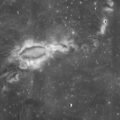3D holograms, while key technology in movies like Star Wars, may be the future of smartphone communication. A new study from the Korea Institute of Science and Technology, published in ACS Nano, shows the successful development of a device that can create miniature 3D holograms.
Background: A Brief Dive into 3D Hologram Technology
3D Holograms, and their scientific field of holography, are quite tricky topics to explain. Holography is a method that allows a light field (where light is scattered off an object) to be recorded and then constructed. When the original subject is no longer present. A hologram is a 3D image resulting from holography. There are many different types of holograms, including ones created by lasers. Many times, 3D holograms must be produced using a specialized camera with a polarizing filter. This camera detects the hologram and then captures the image.
Analysis: Photodiodes in 3D Holograms
In order to make miniaturized holograms without special cameras, the team of researchers at the Korea Institute of Science and Technology used photodiodes in their new device. Photodiodes are special types of semiconductors that convert light into electric current. Depending on the photodiode, these semiconductors can range in size and may include optical filters or built-in lenses. Photodiodes are already essential parts of smartphones and digital cameras.
These cameras can sense the polarization of light, where light traveling in a specific wave shape. This can help them detect the subject of an image, or where to auto-focus. Being able to sense this light change creates an opportunity to store holograms. But this also limits the size of the device being used, as cameras can only sense light change at a larger light spectrum.
In order to make a tiny device for a smartphone, the researchers created a custom photodiode that included a light polarization sensor. This device was created from the inorganic compounds of tungsten diselenide and rhenium diselenide. Both of these materials helped with the photodetection of different wavelengths of light, specifically in the near-infrared region (dark red light in our visible spectrum). This specialized device would replace hologram cameras and essentially work by sensing a digital holographic image and recording it. This small device could easily be added to a smartphone, implying a new trend of communication technology.
Outlook: 3D Holograms Everywhere
This new device may also have a big impact on other industries as well. According to the research team leader Dr. Min-Chul Park: “The new sensor can further detect near-infrared light, as well as previously undetectable visible light, opening up new opportunities in various fields such as 3D night vision, self-driving, biotechnology, and near-infrared data acquisition for analyzing and storing cultural assets.” With tiny sensors being used to detect small light shifts and create holograms, industries like home security or the auto-industry may find themselves adapting to use this new technology. It may not be too long before holograms are rather commonplace, on streets, offices, and even in our homes.
Kenna Castleberry is a staff writer at the Debrief and the Science Communicator at JILA (a partnership between the University of Colorado Boulder and NIST). She focuses on deep tech, the metaverse, and quantum technology. You can find more of her work at her website: https://kennacastleberry.com/
